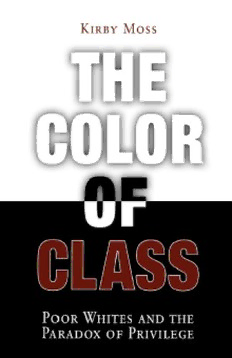
The Color of Class: Poor Whites and the Paradox of Privilege PDF
Preview The Color of Class: Poor Whites and the Paradox of Privilege
The Color of Class This page intentionally left blank The Color of Class Poor Whites and the Paradox of Privilege Kirby Moss PENN University of Pennsylvania Press Philadelphia Copyright © 2003 University of Pennsylvania Press All rights reserved Printed in the United Stales of America on acid-free paper 10 9 8 7 6 5 4 3 2 1 Published by University of Pennsylvania Press Philadelphia, Pennsylvania 19104-401 1 Library of Congress Cataloging-in-Publication Data Moss, Kirby. The color of class: poor whites and the paradox of privilege / Kirby Moss. p. cm. Includes bibliographical references and index. ISBN 0-8122-3733-1 (cloth : alk. paper)—ISBN 0-8122-1851-5 (pbk. : alk. paper) 1. Poor—United States. 2. Social classes—United States. I. Title. HV4045.M67 2003 305.5'69'0973—dc21 2003044764 For my mother. I miss you. This page intentionally left blank Contents Introduction 1 1. Setting: Midway, U.S.A., an Unassuming City? 9 2. School: Learning to Live Up to the Paragon 19 3. Encounters: Intersections and Collisions 43 4. Income and Work: Making Ends Meet, Barely 55 5. Encounters: Changing Contexts, Changing Characters 73 6. Home: Sheltered by Whiteness 78 7. Encounters: Uncommon Class Commonalities 94 8. Deconstructing the Color of Class 100 Conclusion 121 Notes 125 References 143 Index 155 Acknowledgments 161 This page intentionally left blank Introduction As a child, I watched with a curious fascination the few White chil- dren and families who lived on the edge of our neighborhood of Black families. In elementary school, I watched (and participated, I admit) my Black classmates point, whisper, and laugh at the tat- tered clothes, hair, and lives of the two White kids—a boy and a girl—who sat in the back of the class. Since social difference has dis- tinct ways of dividing people, all I and the few White families in the neighborhood did for the most part was watch each other from a distance in wonder and scorn. Ironically, even though we lived a few blocks away in our neighborhood or sat a seat or two away in elementary school, a vast chasm of class and racial difference sepa- rated us from them. Over the years, 1 have often wondered who these people actually were. Why were they so poor compared to us? They no doubt ex- isted, at least in our neighborhood and city, but why were people like them seldom represented in the newspapers and on television shows? And why were they assumed to be better than we were even though we seemed better off than they—hygienically, socially, and even economically? We, solidly working class. They, a teetering lower class, or as we called them, never really knowing any different: poor White trash.l
